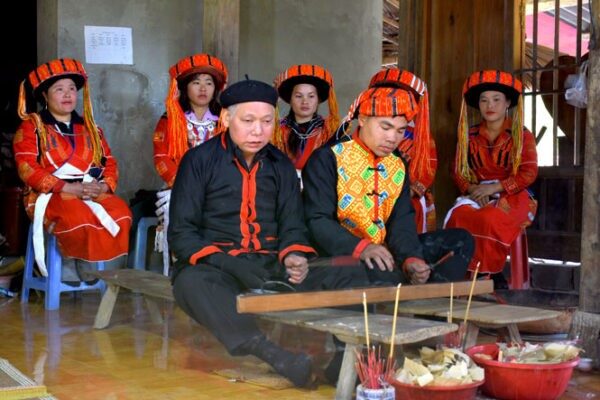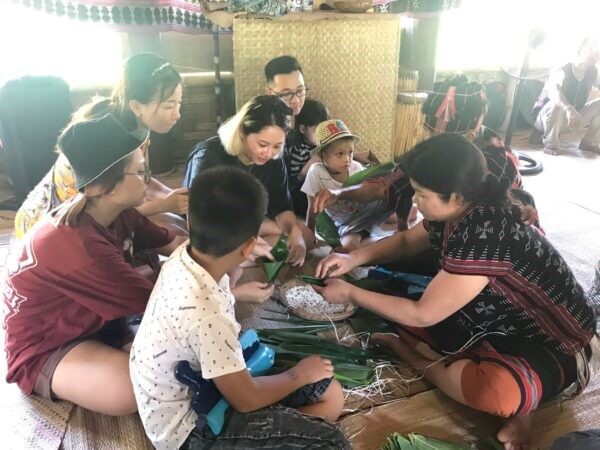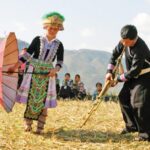The “Happy Independence Day” will have various groups of activities, including: themed group on “Colors of Tuyen area”; that on “Colors of Central Highland”, weekend activities; and daily activities, thereby introducing the culture, customs and habits of 54 ethnic groups in Vietnam at “Common House”. The Day will also contribute to promoting and preserving unique cultural values and enhancing exchanges among ethnic groups, contributing to attracting tourists and making the Vietnam National Village for Ethnic Culture and Tourism a tourist destination.

Sound of pan-pipes seems to have become a method for H’mong people to convey and express their thoughts and aspirations.
The group of themed activities on “Colors of Tuyen area” will cover the following programs: “Upland fair – Colors of Tuyen area”; “Colors of the fair”; introduction of special features of the pan-pipe dance of the H’mong people in Tuyen Quang province; Recreation of “wedding ceremony” of the Dao people; recreation of Cap sac ceremony of the Pa Then people in Tuyen Quang province
The “Upland fair – Colors of Tuyen” program recreates the colorful cultural space of the ethnic groups in the Northeast whose highlight is the cultural space of Tuyen Quang highland market with 50 stalls introducing local products, OCOP products, traditional cuisine of ethnic groups in Tuyen Quang, etc.
The “Colors of the fair” program of the ethnic communities in the Northern Upland Market will have folk songs and dances, cultural exchanges among participating ethnic communities at the Upland Market.
Visitors to the village on this occasion will learn and enjoy the unique features in the art of the panpipe dance of the H’mong people in Tuyen Quang province. The Panpipe is a unique instrument expressing traditional rituals and beliefs and is a sacred object in the festive rituals of the H’mong People. Its sound seems to have become a way for the H’mong people to convey and express their beliefs and aspirations. H’mong people produce its happy sound when they want to invite their friends to go out in the spring, to the market, wish each other good luck. But when they are send, they will make slow and deep sound.
The “Wedding Ceremony” program of the Dao people will recreate one of the special rituals still being handed down to this day – the wedding ceremony of the Red Dao people. The ceremony begins at the groom’s house with representatives and a ritual music band of the Dao people consisting of panpipes, drums, gongs, cymbals, and rods going to the bride’s house to ask for the bride. Its special feature is the bride’s costume with a large red headpiece with many flower buds knitted from red wool, interspersed with brass music bells. Her costume shows sophistication in each traditional embroidered brocade pattern, etc. The society is developing more and more, many customs of the Red Dao people have been lost over time, but their wedding rituals are still handed down by the Red Dao people to educate their descendants because it contains many elements of their culture and history.

Cap Sac ceremony of Pa Then people in Lam Binh district, Tuyen Quang province will be recreated. Minh Hoa’s photo
The program on Cap sac ceremony of the Pa Then people in Tuyen Quang province will recreate an indispensable custom in the spiritual life of the Pa Then people in Lam Binh district, Tuyen Quang province. For them, the ceremony is not an affirmation of a man’s maturity (like the Dao), but a recognition of being allowed to perform religious rituals, being blessed by the gods, and being allowed to act as a shaman in the rituals of worshiping gods and ancestors, etc. Therefore, only men who act as shamans can be entitled to the Cap sac ceremony. A Pa Then man who wants to have a Cap sac ceremony and work as a shaman must learn to worship for a long time, this is a mandatory condition before performing the ceremony.
The group of activities on “Colors of the Central Highlands” includes recreation of the buffalo eating ceremony, called xa o kpieu of the Cor people in Quang Ngai province. The Cor people hold the Buffalo Eating Ceremony upon good business, celebrating a new house or relocating from the village to a new place or when the village has many sick people, to thank the gods and pray for peace and prosperity. Besides the Buffalo Eating Ceremony, goong fighting is also one of the unique activities of the Cor people. Through sounds of the gongs, the way of gong fighting, the Cor people express their gratitude to the gods, pray for favorable weather and good crops.
The weekend activities include performances of Vietnam Circus Federation with special shows such as animal circus, magic tricks, circus clowns, juggling, playing with hoops, acrobatics, etc.; “Mid-Autumn Festival for you” program with activities such as lantern procession, lion dance, traditional games, introduction of performances and interactions of traditional crafts, etc.

Visitors experienced making cakes with the Co Tu people in the village.
On the last Sunday of September, visitors will experience the Sen Dolta Festival of the Khmer people in Soc Trang province. Sen Dolta, the ceremony to worship ancestors in gratitude for their birth and nurture, is one of the great festivals of the year of the Khmer people.
In addition, in the space of the villages, the lives of their people will be recreated daily with many activities such as: performing traditional crafts, introducing food, folk songs and dances of the Nung, Tay, Mong, Dao, Muong, Thai, Ta Oi, Ba Na, Xo Dang, Gia Rai, Co Tu, Raglai, Ede, Khmer, etc., with attention to enhanced experiences for travelers.
V.H

